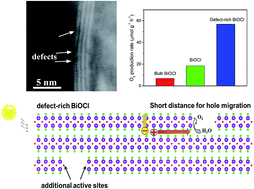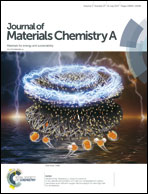Defect engineering in atomically-thin bismuth oxychloride towards photocatalytic oxygen evolution†
Abstract
Photocatalytic solar energy conversion is a clean technology for producing renewable energy sources, but its efficiency is greatly hindered by the kinetically sluggish oxygen evolution reaction. Herein, confined defects in atomically-thin BiOCl nanosheets were created to serve as a remarkable platform to explore the relationship between defects and photocatalytic activity. Surface defects can be clearly observed on atomically-thin BiOCl nanosheets from scanning transmission electron microscopy images. Theoretical/experimental results suggest that defect engineering increased states of density and narrowed the band gap. With combined effects from defect induced shortened hole migratory paths and creation of coordination-unsaturated active atoms with dangling bonds, defect-rich BiOCl nanosheets displayed 3 and 8 times higher photocatalytic activity towards oxygen evolution compared with atomically-thin BiOCl nanosheets and bulk BiOCl, respectively. This successful application of defect engineering will pave a new pathway for improving photocatalytic oxygen evolution activity of other materials.



 Please wait while we load your content...
Please wait while we load your content...